2025届高考英语二轮复习第2部分专题二阅读七选五课件(共22张PPT)
文档属性
| 名称 | 2025届高考英语二轮复习第2部分专题二阅读七选五课件(共22张PPT) |  | |
| 格式 | ppt | ||
| 文件大小 | 488.0KB | ||
| 资源类型 | 教案 | ||
| 版本资源 | 通用版 | ||
| 科目 | 英语 | ||
| 更新时间 | 2025-04-27 17:08:36 | ||
图片预览

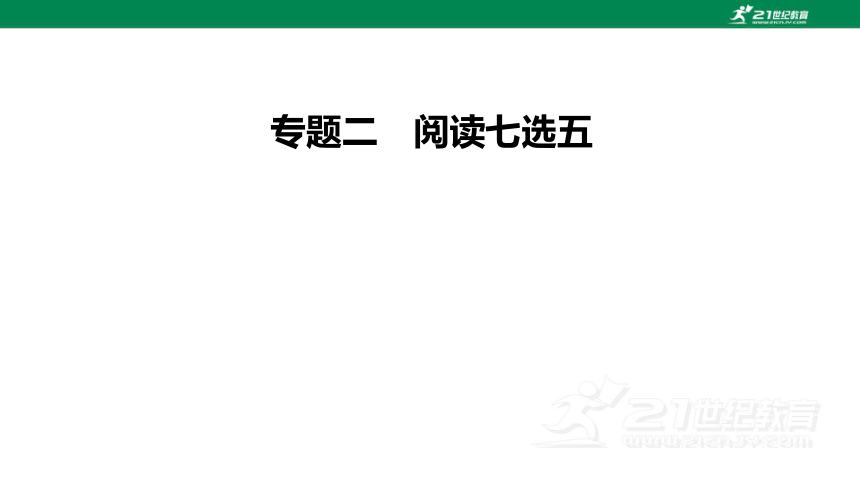


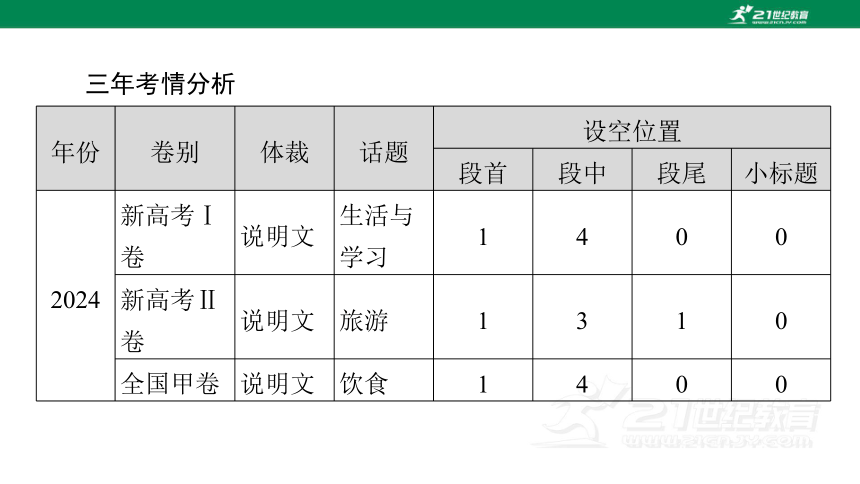
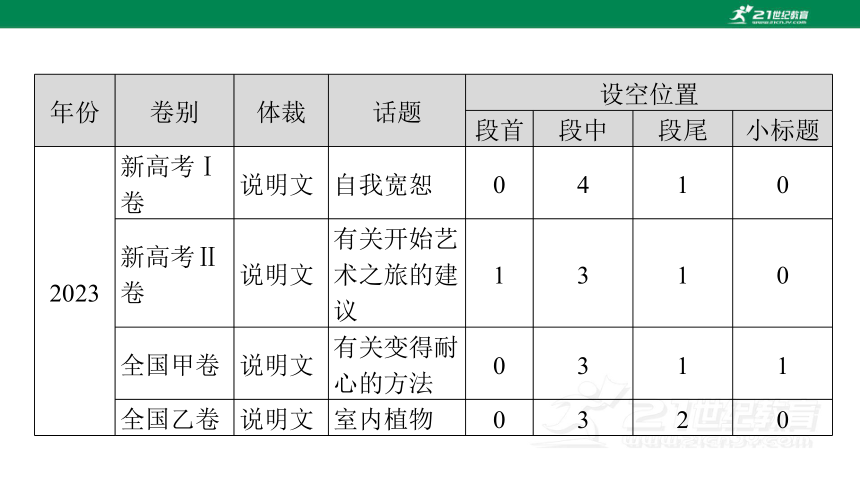

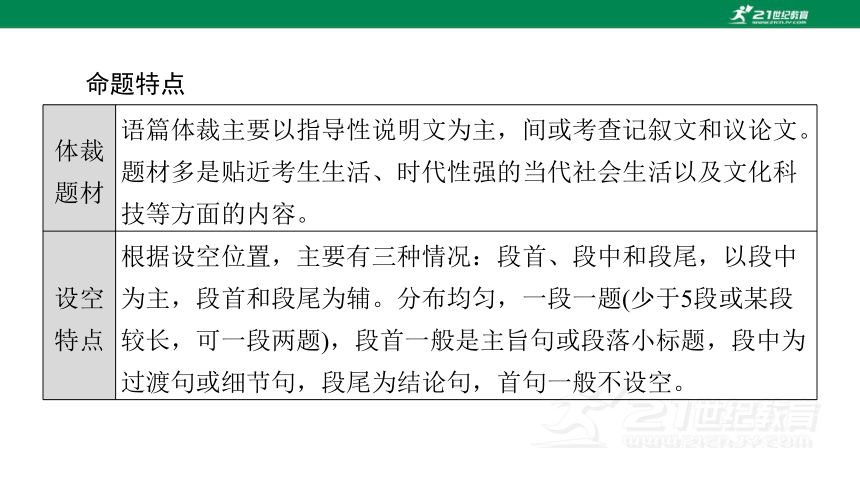
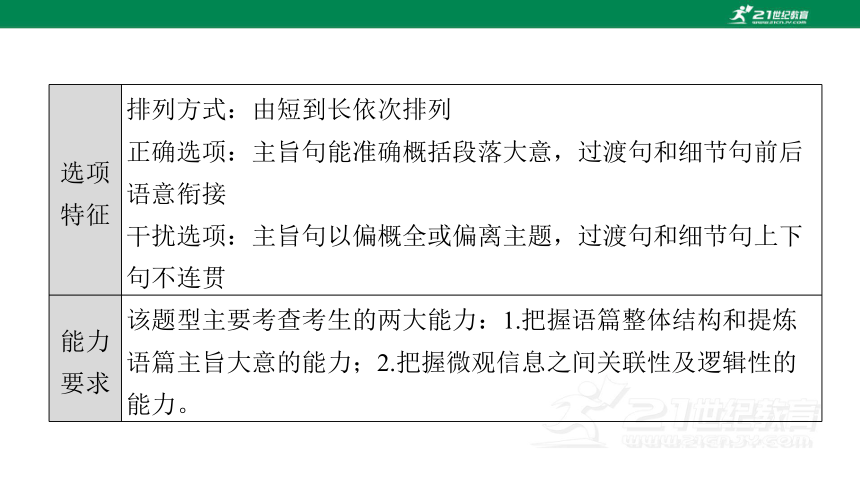
文档简介
(共22张PPT)
阅读能力突破篇
专题二 阅读七选五
考情分析 明方向
阅读七选五题型主要考查考生对语篇的整体内容和结构以及上下文行文逻辑的理解和掌握。该题型的命题形式是一篇300词左右的短文,在短文中去除5处信息,并提供7个备选选项,要求考生从7个选项中选出5个合适的选项对应地填回原文5处空缺处。
三年考情分析
年份 卷别 体裁 话题 设空位置
段首 段中 段尾 小标题
2024 新高考Ⅰ卷 说明文 生活与学习 1 4 0 0
新高考Ⅱ卷 说明文 旅游 1 3 1 0
全国甲卷 说明文 饮食 1 4 0 0
年份 卷别 体裁 话题 设空位置
段首 段中 段尾 小标题
2023 新高考Ⅰ卷 说明文 自我宽恕 0 4 1 0
新高考Ⅱ卷 说明文 有关开始艺术之旅的建议 1 3 1 0
全国甲卷 说明文 有关变得耐心的方法 0 3 1 1
全国乙卷 说明文 室内植物 0 3 2 0
年份 卷别 体裁 话题 设空位置
段首 段中 段尾 小标题
2022 新高考Ⅰ卷 说明文 一起锻炼的伙伴 0 4 1 0
新高考Ⅱ卷 说明文 写文章的技巧 1 4 0 0
全国甲卷 说明文 外出就餐 1 3 1 0
全国乙卷 应用文 维系异地友谊的方法 2 1 1 1
命题特点
体裁题材 语篇体裁主要以指导性说明文为主,间或考查记叙文和议论文。题材多是贴近考生生活、时代性强的当代社会生活以及文化科技等方面的内容。
设空特点 根据设空位置,主要有三种情况:段首、段中和段尾,以段中为主,段首和段尾为辅。分布均匀,一段一题(少于5段或某段较长,可一段两题),段首一般是主旨句或段落小标题,段中为过渡句或细节句,段尾为结论句,首句一般不设空。
选项特征 排列方式:由短到长依次排列
正确选项:主旨句能准确概括段落大意,过渡句和细节句前后语意衔接
干扰选项:主旨句以偏概全或偏离主题,过渡句和细节句上下句不连贯
能力要求 该题型主要考查考生的两大能力:1.把握语篇整体结构和提炼语篇主旨大意的能力;2.把握微观信息之间关联性及逻辑性的能力。
掌握攻略 巧破题
解题步骤
速读全文掌握大意→根据设空位置找出与前后文之间的词汇方面的联系→思考与前后文行文逻辑关系→分析选项特征判断其归位。
第一步:先做段首、段尾题,缩小选项排查范围。
因为段首、段尾题要么是主题句或者总结句,要么就是承上启下句,语言特征较为鲜明,且题目相对简单,较易判定。做题时,先将这类题目的选项确定,既可缩小排查范围,又可使原文信息更加明了。
第二步:利用句间语义逻辑关系,排查判定剩余选项。
随着段首、段尾题的判定复位,原文信息进一步明了。再次通读原文,理清剩余空格处与前后句间的关系,将剩余选项判定归位。
第三步:代入选项通读全文,验证是否文意通畅。
将所选答案代入文中,通读全文,重点检查选项与前后文之间的逻辑关系,看是否符合原文整体行文逻辑。
实战导引 点迷津
(2023·新高考Ⅰ卷)
Personal Forgiveness
Taking responsibility for mistakes is a positive step, but don't beat yourself up about them.To err(犯错) is human.36. You can use the following writing exercise to help you do this.
In a journal or on a piece of paper, put the heading “Personal strengths”. 37. Are you caring?Creative?Generous?A good listener?Fun to be around?They don't have to be world-changing, just aspects of your personality that you're proud of.
At the top of a second page, put the heading “Acts of kindness”.On this one, list all the positive things you‘ve done for others.It might be the time when you helped a friend with their homework, when you did the ironing without being asked, or when you baked cookies after the family had had a tiring day.38 。
You could ask a friend or family member to help add to your list. 39. That way, you could exchange thoughts on what makes each of you special and the aspects of your personality that shine through.In fact, don't wait until you've made a mistake to try this—it's a great way to boost self-confidence at any time.
It's something of a cliché(陈词滥调) that most people learn not from their successes but their mistakes.The thing is, it's true.40. We're all changing and learning all the time and mistakes are a positive way to develop and grow.
A.A little self-forgiveness also goes a long way.
B.Now list all the characteristics you like about yourself.
C.They might even like to have a go at doing the exercise.
D.It's just as important to show yourself some forgiveness.
E.It doesn't mean you have to ignore what's happened or forget it.
F.Whatever it is, no matter how small it might seem, write it down.
G.Whatever the mistake, remember it isn't a fixed aspect of your personality.
【解题导引】
第一步:速读全文,了解大意,掌握结构:
本文为一篇说明文。文章鼓励人们练习自我宽恕,并提供了一个简单的写作练习来增强自信。通过列出个人的优点和善良的行为,人们可以学会原谅自己的错误,并从中成长;
第二步:根据题目设空位置,结合上下文语境,理清逻辑关系:段中题一般既要关注上文又要兼顾下文的逻辑关系。段尾题多关注总结概括。
36.段中题。根据前文“Taking responsibility for mistakes is a positive step, but don't beat yourself up about them.To err (犯错) is human.(为错误承担责任是积极的一步,但不要因此而自责。人孰能无过。)”可知,作者认为人都会犯错,勇于承担责任固然重要,但是也不要因此而过于自责。结合后文“You can use the following writing exercise to help you do this.(你可以使用下面的写作练习来帮助你做到这一点。)”中的“do this”以及下文内容可推断,空处应该和“不要太自责”相似。选项“It's just as important to show yourself some forgiveness.(宽恕自己也同样重要。)”与“不要太自责”语意相近,起承上启下的作用。故选D。
37.段中题。根据前文“In a journal or on a piece of paper, put the heading ‘Personal strengths’.(在日记或纸上写上‘个人优点’。)”以及后文“Are you caring?Creative?Generous?A good listener?Fun to be around?They don't have to be world-changing, just aspects of your personality that you're proud of.(你有爱心吗?有创造力吗?你慷慨吗?是一个好的倾听者吗?与人相处很有趣吗?它们不一定要改变世界,只要你个性中让你感到自豪的方面就行。)”可知,空处指的是列出一些你个性中的优点。选项“Now list all the characteristics you like about yourself.(现在列出所有你喜欢的自己身上的特点。)”符合上下文内容,下文内容具体解释哪些是优点。故选B。
38.段尾题。根据上文“At the top of a second page, put the heading ‘Acts of kindness’.On this one, list all the positive things you've done for others.It might be the time when you helped a friend with their homework, when you did the ironing without being asked, or when you baked cookies after the family had had a tiring day.(在第二页的顶部,写上‘善举’的标题。在这张单子上,列出你为别人做过的所有积极的事情。它可能是当你帮助朋友做作业的时候,当你没有被要求却主动熨衣服的时候,或者当你在家人累了一天之后烤饼干的时候。)”可知,本段主要讲述的是列出一些自己所做的好事。选项“Whatever it is, no matter how small it might seem, write it down.(不管是什么,不管它看起来有多小,都要把它写下来。)”对上文进行总结概括,你所做的事情不管有多小,只要是好的事情,都记下来。故选F。
39.段中题。根据后文“That way, you could exchange thoughts on what makes each of you special and the aspects of your personality that shine through.(这样,你们就可以交换意见,谈谈是什么让你们每个人都与众不同,以及你们个性中闪光的方面。)”可知,空处提到了某种方式,这种方式会使得你和朋友们一起交换意见等。选项“They might even like to have a go at doing the exercise.(他们甚至可能想试一试做练习。)”符合语境,其中They与空前的“You could ask a friend or family member to help add to your list.(你可以让朋友或家人帮你增加你的列表内容。)”中的“a friend or family member”保持一致,同时该选项和下文“In fact, don't wait until you've made a mistake to try this—it's a great way to boost self-confidence at any time.(事实上,不要等到你犯了错误才去尝试这个——这是一个在任何时候都能增强自信的好方法。)”中的this一致。故选C。
40.段中题。根据前文“It's something of a cliché (陈词滥调) that most people learn not from their successes but their mistakes.The thing is, it's true.(大多数人不是从他们的成功中学习,而是从他们的错误中学习,这是陈词滥调。但事实是,这是真的。)”可知,作者认为人是从错误中学习。选项“Whatever the mistake, remember it isn't a fixed aspect of your personality.(不管你犯了什么错误,记住这不是你性格中固定的一面。)”符合语境,其中“isn't a fixed aspect of your personality”和后文“We're all changing and learning all the time and mistakes are a positive way to develop and grow.(我们一直在改变和学习,错误是一种积极的发展和成长的方式。)”保持一致,指的都是犯错并不是性格中固有的一面,我们是通过错误来成长。故选G。
阅读能力突破篇
专题二 阅读七选五
考情分析 明方向
阅读七选五题型主要考查考生对语篇的整体内容和结构以及上下文行文逻辑的理解和掌握。该题型的命题形式是一篇300词左右的短文,在短文中去除5处信息,并提供7个备选选项,要求考生从7个选项中选出5个合适的选项对应地填回原文5处空缺处。
三年考情分析
年份 卷别 体裁 话题 设空位置
段首 段中 段尾 小标题
2024 新高考Ⅰ卷 说明文 生活与学习 1 4 0 0
新高考Ⅱ卷 说明文 旅游 1 3 1 0
全国甲卷 说明文 饮食 1 4 0 0
年份 卷别 体裁 话题 设空位置
段首 段中 段尾 小标题
2023 新高考Ⅰ卷 说明文 自我宽恕 0 4 1 0
新高考Ⅱ卷 说明文 有关开始艺术之旅的建议 1 3 1 0
全国甲卷 说明文 有关变得耐心的方法 0 3 1 1
全国乙卷 说明文 室内植物 0 3 2 0
年份 卷别 体裁 话题 设空位置
段首 段中 段尾 小标题
2022 新高考Ⅰ卷 说明文 一起锻炼的伙伴 0 4 1 0
新高考Ⅱ卷 说明文 写文章的技巧 1 4 0 0
全国甲卷 说明文 外出就餐 1 3 1 0
全国乙卷 应用文 维系异地友谊的方法 2 1 1 1
命题特点
体裁题材 语篇体裁主要以指导性说明文为主,间或考查记叙文和议论文。题材多是贴近考生生活、时代性强的当代社会生活以及文化科技等方面的内容。
设空特点 根据设空位置,主要有三种情况:段首、段中和段尾,以段中为主,段首和段尾为辅。分布均匀,一段一题(少于5段或某段较长,可一段两题),段首一般是主旨句或段落小标题,段中为过渡句或细节句,段尾为结论句,首句一般不设空。
选项特征 排列方式:由短到长依次排列
正确选项:主旨句能准确概括段落大意,过渡句和细节句前后语意衔接
干扰选项:主旨句以偏概全或偏离主题,过渡句和细节句上下句不连贯
能力要求 该题型主要考查考生的两大能力:1.把握语篇整体结构和提炼语篇主旨大意的能力;2.把握微观信息之间关联性及逻辑性的能力。
掌握攻略 巧破题
解题步骤
速读全文掌握大意→根据设空位置找出与前后文之间的词汇方面的联系→思考与前后文行文逻辑关系→分析选项特征判断其归位。
第一步:先做段首、段尾题,缩小选项排查范围。
因为段首、段尾题要么是主题句或者总结句,要么就是承上启下句,语言特征较为鲜明,且题目相对简单,较易判定。做题时,先将这类题目的选项确定,既可缩小排查范围,又可使原文信息更加明了。
第二步:利用句间语义逻辑关系,排查判定剩余选项。
随着段首、段尾题的判定复位,原文信息进一步明了。再次通读原文,理清剩余空格处与前后句间的关系,将剩余选项判定归位。
第三步:代入选项通读全文,验证是否文意通畅。
将所选答案代入文中,通读全文,重点检查选项与前后文之间的逻辑关系,看是否符合原文整体行文逻辑。
实战导引 点迷津
(2023·新高考Ⅰ卷)
Personal Forgiveness
Taking responsibility for mistakes is a positive step, but don't beat yourself up about them.To err(犯错) is human.36. You can use the following writing exercise to help you do this.
In a journal or on a piece of paper, put the heading “Personal strengths”. 37. Are you caring?Creative?Generous?A good listener?Fun to be around?They don't have to be world-changing, just aspects of your personality that you're proud of.
At the top of a second page, put the heading “Acts of kindness”.On this one, list all the positive things you‘ve done for others.It might be the time when you helped a friend with their homework, when you did the ironing without being asked, or when you baked cookies after the family had had a tiring day.38 。
You could ask a friend or family member to help add to your list. 39. That way, you could exchange thoughts on what makes each of you special and the aspects of your personality that shine through.In fact, don't wait until you've made a mistake to try this—it's a great way to boost self-confidence at any time.
It's something of a cliché(陈词滥调) that most people learn not from their successes but their mistakes.The thing is, it's true.40. We're all changing and learning all the time and mistakes are a positive way to develop and grow.
A.A little self-forgiveness also goes a long way.
B.Now list all the characteristics you like about yourself.
C.They might even like to have a go at doing the exercise.
D.It's just as important to show yourself some forgiveness.
E.It doesn't mean you have to ignore what's happened or forget it.
F.Whatever it is, no matter how small it might seem, write it down.
G.Whatever the mistake, remember it isn't a fixed aspect of your personality.
【解题导引】
第一步:速读全文,了解大意,掌握结构:
本文为一篇说明文。文章鼓励人们练习自我宽恕,并提供了一个简单的写作练习来增强自信。通过列出个人的优点和善良的行为,人们可以学会原谅自己的错误,并从中成长;
第二步:根据题目设空位置,结合上下文语境,理清逻辑关系:段中题一般既要关注上文又要兼顾下文的逻辑关系。段尾题多关注总结概括。
36.段中题。根据前文“Taking responsibility for mistakes is a positive step, but don't beat yourself up about them.To err (犯错) is human.(为错误承担责任是积极的一步,但不要因此而自责。人孰能无过。)”可知,作者认为人都会犯错,勇于承担责任固然重要,但是也不要因此而过于自责。结合后文“You can use the following writing exercise to help you do this.(你可以使用下面的写作练习来帮助你做到这一点。)”中的“do this”以及下文内容可推断,空处应该和“不要太自责”相似。选项“It's just as important to show yourself some forgiveness.(宽恕自己也同样重要。)”与“不要太自责”语意相近,起承上启下的作用。故选D。
37.段中题。根据前文“In a journal or on a piece of paper, put the heading ‘Personal strengths’.(在日记或纸上写上‘个人优点’。)”以及后文“Are you caring?Creative?Generous?A good listener?Fun to be around?They don't have to be world-changing, just aspects of your personality that you're proud of.(你有爱心吗?有创造力吗?你慷慨吗?是一个好的倾听者吗?与人相处很有趣吗?它们不一定要改变世界,只要你个性中让你感到自豪的方面就行。)”可知,空处指的是列出一些你个性中的优点。选项“Now list all the characteristics you like about yourself.(现在列出所有你喜欢的自己身上的特点。)”符合上下文内容,下文内容具体解释哪些是优点。故选B。
38.段尾题。根据上文“At the top of a second page, put the heading ‘Acts of kindness’.On this one, list all the positive things you've done for others.It might be the time when you helped a friend with their homework, when you did the ironing without being asked, or when you baked cookies after the family had had a tiring day.(在第二页的顶部,写上‘善举’的标题。在这张单子上,列出你为别人做过的所有积极的事情。它可能是当你帮助朋友做作业的时候,当你没有被要求却主动熨衣服的时候,或者当你在家人累了一天之后烤饼干的时候。)”可知,本段主要讲述的是列出一些自己所做的好事。选项“Whatever it is, no matter how small it might seem, write it down.(不管是什么,不管它看起来有多小,都要把它写下来。)”对上文进行总结概括,你所做的事情不管有多小,只要是好的事情,都记下来。故选F。
39.段中题。根据后文“That way, you could exchange thoughts on what makes each of you special and the aspects of your personality that shine through.(这样,你们就可以交换意见,谈谈是什么让你们每个人都与众不同,以及你们个性中闪光的方面。)”可知,空处提到了某种方式,这种方式会使得你和朋友们一起交换意见等。选项“They might even like to have a go at doing the exercise.(他们甚至可能想试一试做练习。)”符合语境,其中They与空前的“You could ask a friend or family member to help add to your list.(你可以让朋友或家人帮你增加你的列表内容。)”中的“a friend or family member”保持一致,同时该选项和下文“In fact, don't wait until you've made a mistake to try this—it's a great way to boost self-confidence at any time.(事实上,不要等到你犯了错误才去尝试这个——这是一个在任何时候都能增强自信的好方法。)”中的this一致。故选C。
40.段中题。根据前文“It's something of a cliché (陈词滥调) that most people learn not from their successes but their mistakes.The thing is, it's true.(大多数人不是从他们的成功中学习,而是从他们的错误中学习,这是陈词滥调。但事实是,这是真的。)”可知,作者认为人是从错误中学习。选项“Whatever the mistake, remember it isn't a fixed aspect of your personality.(不管你犯了什么错误,记住这不是你性格中固定的一面。)”符合语境,其中“isn't a fixed aspect of your personality”和后文“We're all changing and learning all the time and mistakes are a positive way to develop and grow.(我们一直在改变和学习,错误是一种积极的发展和成长的方式。)”保持一致,指的都是犯错并不是性格中固有的一面,我们是通过错误来成长。故选G。
